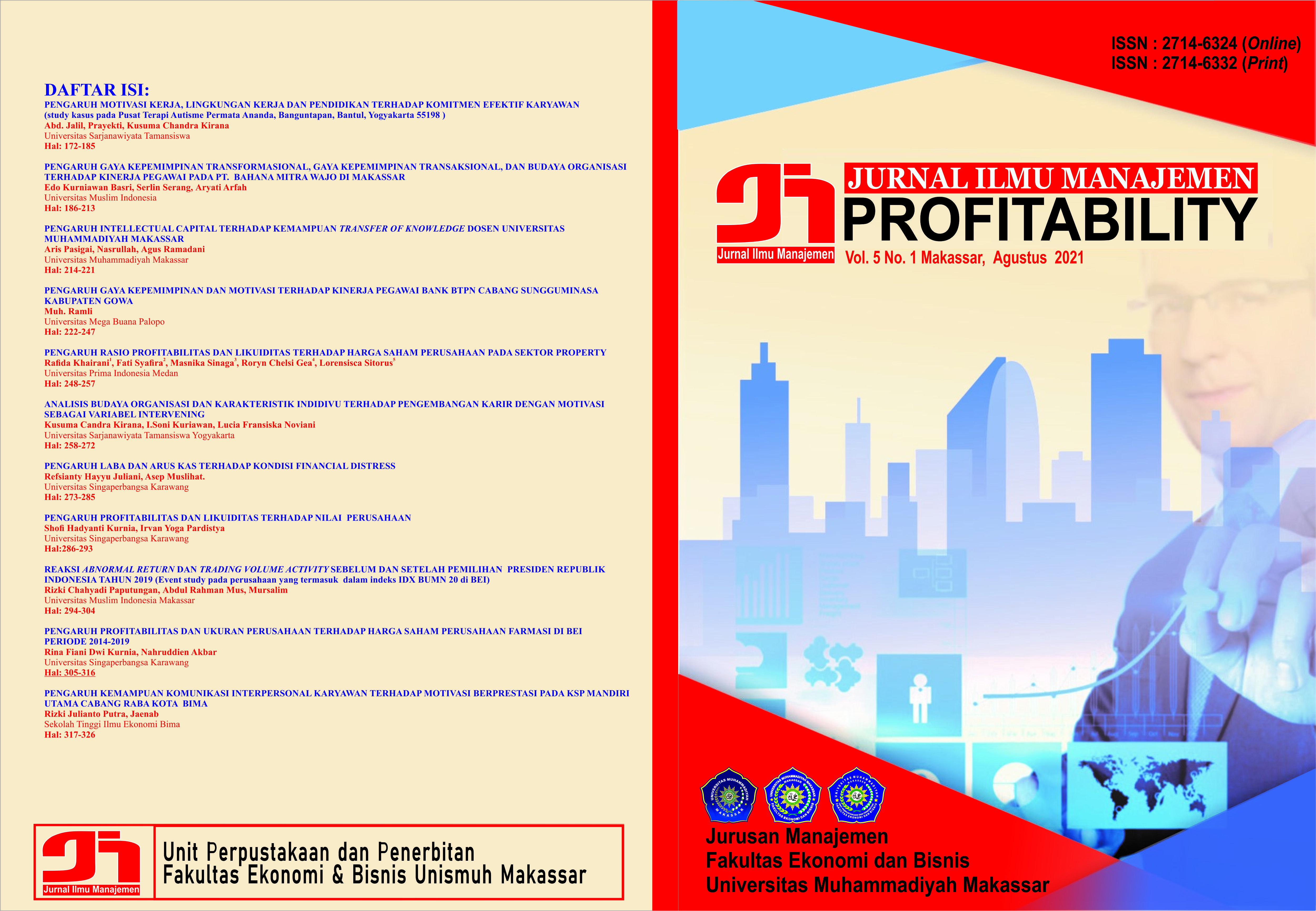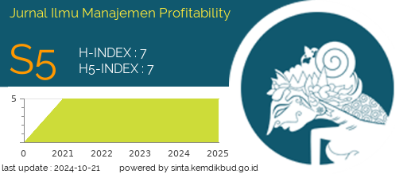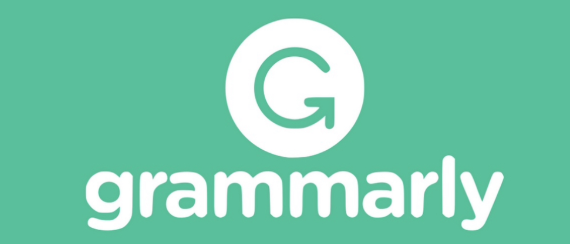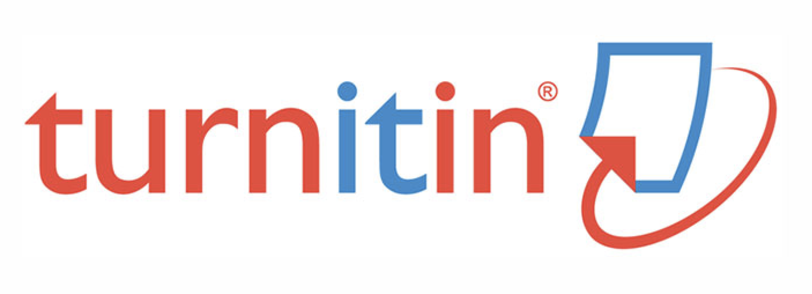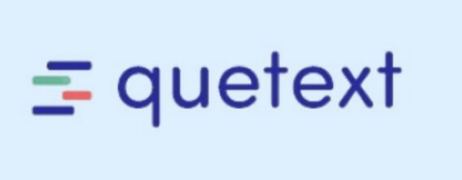INFLUENCE OF PROFIT AND CASH FLOW ON FINANCIAL DISTRESS CONDITIONS
DOI: https://doi.org/10.26618/profitability.v5i2.5905
Profit, Return On Asset, Cash Flow, Operating Cash Flow, Financial Distress.
Abstract
Food and Beverage Company is the mainstay company of the manufacturing industry therefore creating strong competition that occurs in it. Companies that are unable to compete and improve their performance will experience financial difficulties and eventually head into bankruptcy. This research aims to find out how much influence profit and cash flow have on the Financial Distress of food and beverage companies listed on the Indonesia Stock Exchange in 2014-2019. The research method used is verification descriptive with a quantitative approach. The results of the verification analysis state that partial return on assets is influential and significant to financial distress. Meanwhile, cash flow indicates that cash flow (operating cash flow ratio) has a negative and significant financial distress. Simultaneously, profit and cash flow accounted for 41.7% of financial distress while the remaining 58.3% was explained by other variables beyond the multiple regression equations or those not studied in this studyReferences
Carolina, verani., Elyzabet I. Marpaung, dan Derry Pratama. 2017. Analisis Rasio Keuangan Untuk Memprediksi Kondisi Financial Distress (studi empiris pada perusahaan manufaktur yang terdaftar di bursa efek indonesia periode 2014-2015). Jurnal Akuntansi. 9(2).
Darsono dan Ashari. 2005. Pedoman Praktis Memahami Laporan Keuangan. Jakarta: Salemba Empat
Djongkang, F, dan Maria Rio Rita. 2014. Manfaat Laba dan Arus Kas Untuk Memprediksi Kondisi Financial Distress. 247-255.
Fahlevi, MR., dan Aan Marlinah. 2018. The Influence of Liquidity, Capital Struckture, Profitability and Cash Flow on The Company’s Financial Distress. Jurnal Bisnis dan Akuntansi. 20(1): 59-68.
Hery. 2016. Analisis Laporan Keuangan (Integrated and Comperhensive Edition). Jakarta: PT Gramedia Widiasarana Indonesia.
Harahap, SS. 2011. Analisis Kritis Atas Laporan Keuangan (Edisi 1). Jakarta: PT. Raja Grafindo Persada.
Julius, F. 2017. Pengaruh Finacial Leverage, Firm Growth, Laba Dan Arus Kas Terhadap Financial Distress (Studi Empiris pada Perusahaan Manufaktur yang Terdaftar di Bursa Efek Indonesia Tahun 2010-2014). 4(1).
Kasmir. 2018. Analisis Laporan Keuangan. Depok: PT Raja Grafindo Persada.
Nukmaningtyas, Fira dan Saparila Worokinasih. 2018. Penggunaan Rasio Profitabilitas, Likuiditas,Leverage Dan Arus Kas Untuk Memprediksi Financial Distress (Studi Pada Perusahaan Sektor Aneka Industri Yang Terdaftar Di Bursa Efek Indonesia Periode 2013-2016). Jurnal Administrasi Bisnis (JAB). 61(2).
Purnomo, RA. Analisis Statistik Ekonomi dan Bisnis dengan SPSS. 2017. Ponorogo: WADE GROUP.
Ratna Sari, Eka dan Mochammad Rizal Yulianto. 2018. Akurasi Pengukuran Financial Distress Menggunakan metode Springate dan Zmijewski pada Perusahaan Property dan Real Estate di Bursa Efek Indonesia Periode 2013-2015. Jurnal Manajemen Bisnis Indonesia. 5(2).
Rudianto. 2013. Akuntansi Manajemen Informasi Pengambilan Keputusan Strategis. Jakarta: Erlangga.
Subramanyam, K.R dan John J. Wild. 2014. Analisis Laporan Keuangan. Penerjemah Dewi Y. Jakarta: Salemba Empat
Suryaningsih, Levi. 2020. Analisis Pengaruh Profitabilitas, Likuiditas, Dan Leverage Terhadap Financial Distress Pada Perusahaan Bumn Yang Terdaftar Di Bursa Efek Indonesia Tahun 2014-2018.
World Economic Forum. 2019. The Global Competitiveness Report. Diunduh tanggal 11 Februari 2020, http://www3.weforum.org/docs/WEF_TheGlobalCompetitivenessReport2019.pdf
Downloads
Published
Issue
Section
License
Authors who publish with Jurnal Ilmu Manajemen Profitability agree to the following terms:
Copyright of the articles remains with the authors.
Authors grant the journal the right of first publication with the work simultaneously licensed under a Creative Commons Attribution-NonCommercial 4.0 International License (CC BY-NC 4.0). This license allows others to:
Share (copy and redistribute the material in any medium or format)
Adapt (remix, transform, and build upon the material)
as long as they give appropriate credit to the original author(s) and source, provide a link to the license, and indicate if changes were made. Non-commercial use only.
Authors are permitted to:
Distribute their published work (e.g., post it to an institutional repository or publish it in a book), with an acknowledgment of its initial publication in this journal.
Enter into separate, additional contractual arrangements for the non-exclusive distribution of the journal’s published version of the work (e.g., post it to a class website or institutional archive).
For permissions to use the content published in this journal beyond the scope of the license (e.g., commercial purposes), please contact the editorial office via the journal email.
License Details:
This journal is licensed under a Creative Commons Attribution-NonCommercial 4.0 International License (CC BY-NC 4.0).

